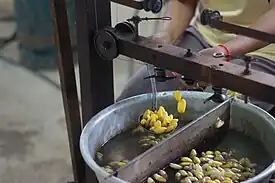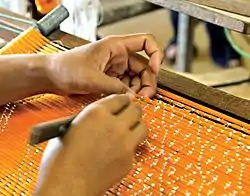
Artisans Angkor is a Cambodian social business creating job opportunities for young people in rural areas, while reviving traditional Khmer craftsmanship (stone and wood carving, painting on statues and on silk, lacquering, and silver plating).[1]
The organisation, founded in 1992, is located on Stung Thmey Street, 2 minutes walk from the Old Market in Siem Reap centre, Cambodia.
Two sites are open to the public in Siem Reap: one specializing in crafts located on Stung Thmey Street and the other specializing in silk at the Angkor Silk Farm (20mins drive from Siem Reap centre, in Puok district).[2] Seven shops selling handmade items made by Artisans Angkor can be found in Siem Reap centre, at the Angkor Silk Farm, at the Angkor Café in front of Angkor Wat temple, in Phnom Penh city centre and in Siem Reap and Phnom Penh International Airport as well.[3]
History

Artisans Angkor is a semi-public company whose story started in 1992, with an educational project called "Les Chantiers-Ecoles de Formation Professionnelle" (CEFP) implemented by the Cambodian Ministry of Education.[4] This project aimed at rebuilding the country after the war period by training young people in the building sector, such as masonry, plumbing, tiling, painting, etc. Hence, "Les Chantiers-Ecoles de Formation Professionnelle" developed an educational methodology to provide those skills to underprivileged young Cambodians with little education.
In the mid-1990s, this training was extended to traditional Khmer craftsmanship, as this essential part of the Khmer cultural heritage had almost disappeared. At the end of the training, there were many employment opportunities for the young people trained in the building sector but as the tourism was not yet well-developed in Cambodia at that time, it was more difficult to find a job in the field of handicrafts.
A European program called "REPLIC" provided financial support between 1998 and 2001 to create a project called "Artisans Angkor" to be a workplace for the young Cambodians trained by CEFP in the handicraft sector. In 2003, with support of the Agence Française de Développement (French Agency for Development), Artisans Angkor became an autonomous and semi-public Cambodian company. The profits of the company are wholly reinvested in the new training programs or construction of new workplaces in the Siem Reap province.
The company has developed its own training program (independent from the CEFP) in the craft sector, giving young Cambodians aged from 18 to 25 years free vocational training in stone or wood carving, or lacquering, or silver plating. Young people mostly from remote rural areas close to a new workshop built by Artisans Angkor can apply for this training; they have to pass some of manual and motivational tests. The compensated training period lasts from 6 to 9 months and at the end of this apprenticeship, the trainees are granted the status of "artisans". If they wish, they can then join Artisans Angkor where an employment opportunity is guaranteed to them.
In 2013, Artisans Angkor employs more than 1300 people, of whom 900 are craftsmen and women working in 48 different workshops in the Siem Reap Province. The company provides a higher salary than the average wages in the sector and provides its employees with medical insurance and other benefits.[5]
Cambodian handmade silk

Artisans Angkor is known as one of the finest silk producers in Cambodia.[6] The company has 23 silk workshops in the Siem Reap province. One site only is open to the public: the Angkor Silk Farm[7] in Puok district (about 20-minute drive from the centre of Siem Reap). Artisans specializing in silk are still trained by a unit of the CEFP called the “National Silk Centre” where the Angkor Silk Farm is located.
Silk weaving is a tradition that traces its origins back to the 13th century, as a result of the influence of the Silk Road in South Asia. It became an exclusive vocation for the women of rural villages who produced among others, one of the most famous Cambodian fabrics called “Hol Lboeuk”[8] thanks to the traditional technique of “Ikat”. Artisans Angkor revives this ancient technique in Cambodia in its very traditional way.
Angkor Silk Farm
Angkor Silk Farm is a site gathering many silk workshops belonging to the Cambodian social enterprise Artisans Angkor. Visitors can discover through free guided tours the complete process of sericulture, from the cultivation of the mulberry bushes to the production of silk goods.[9]
Angkor Silk Farm is located in Puok District, a 20-minute drive from Siem Reap centre, Cambodia.[10]
History

Angkor Silk Farm was created by the National Silk Centre (Centre National de la Soie - CNS) in 1993.[11][12] Between 1994 and 1996, the National Silk Centre developed and grew bigger.
While the National Silk Centre has focused on training silk farming to young Cambodian from remote rural areas, Artisans Angkor has provided these trainees with employment at the end of their formation. Indeed, there were few opportunities in this sector in the mid-1990s and Artisans Angkor was founded to become a vocational organism for people trained by the National Silk Centre.[13] Therefore, CNS hosts Artisans Angkor at Angkor Silk Farm and both work closely together.
Since its creation, Artisans Angkor has opened 23 silk workshops in Siem Reap province which makes it the largest employer of the region. Besides fulfilling a social mission,[5] the enterprise is renowned as one of the finest silk producers in Cambodia[14] and Angkor Silk Farm has been one of the great attractions of Siem Reap for visitors eager to discover the secrets of handmade silk production.[6]
Silk-making process

Angkor Silk Farm is surrounded by 5 hectares of mulberry trees plantation. These fields are the starting point of the whole process of silk-making as silk worms will eat and grow on them. The trees can grow two meters tall and branches are cut four times a year. Mulberry leaves are silkworms' favourite food and will be eaten for weeks. During the last days, silkworms can eat ten times a day.[15]
When the worms have grown enough, they are put in baskets. From there, they will spin their cocoons in five days and will produce about three hundreds meters of silk each. The cocoons are then put in sunlight to avoid them undergoing their metamorphosis into mature moths. However, 20% of them reach the breeding process and the female moths will lay and hatch its eggs within nine to twelve days.[16]

The cocoons are soaked in hot water in order to soften the sericin (also known as silk gum) which coat the fibres and stick the cocoons together. Silk threads are then unwound and reeled together to produce a single thread. Weavers at Angkor Silk Farm make both raw silk and fine silk that do not have the same texture at all. Sericin has not been completely removed from raw silk threads, which will give a rougher texture to the fabric at the end.
The silk is then dyed by putting natural materials or artificial and environmentally friendly dyes in boiling water. Natural dyes can be created out of bananas, coconut barks, leaves, roots, etc. but fruits and trees don't always have the same hues depending on the seasons which make the use of artificial products necessary to reach the same colour. The dyeing process has to be renewed several times as artisans weave silk fabrics in the old way through the Ikat technique.[17]
The Ikat weaving technique

The Ikat technique (also called "chong kiet" in Khmer) is one of the most ancient weaving techniques in the world and is used to create designs in fabrics. Artisans create a tight knot resistant to dyes which forms an original pattern with the complex intertwining of the warp thread and the weft thread.[18]
One of the most famous and gorgeous kind of silk fabrics in Cambodia is called "Hol Lboeuk"[8] and can only be created with the Ikat technique. Successive tying-in and dyeing process with different colours will yield the fabric geometric or floral motifs.[19]

The threads are then tied-up to a frame. The warp chain will individually pass through dents of the reed to be rolled up again on the cylinder placed in front of the loom. In the meantime, the weaver alternately pedal up and down on the levers to overhang the frame, and to provide the route for the shuttle that carries the weft threads to move from right to left. After each passage of the shuttle, the reed will join and tighten the threads together to make the full fabric. This lengthy and time-consuming process creates the desired pattern.
Cambodian traditional crafts

Artisans Angkor had set up as a training centre in order to bring back ancient Arts and Crafts of the Angkor region. Stone and wood carvings are the skills which are mostly renowned in the Siem Reap region as they recall the nearby pagodas and Angkor temples with their famous bas-relief carvings. Most temples in the region of Angkor that were built in the 11th-12th centuries have such carvings. Statues often represent famous characters of the Buddhism or Hinduism mythologies such as Buddha, Shiva and Vishnu, etc.
For every craft, each artisan has its own way of working. If his/her movement is gentle rather than firm, the final piece will turn out to be slightly different from the other ones, which makes of each craft work a unique piece.
Artisans Angkor also masters the arts of polychrome and lacquering which have different processes depending on the medium used as a basis (wood or stone). Lacquerware and polychrome products are often gilded with copper or golden leaves.
For the silk painting, craftsmen set up the silk material on a frame, and then draw motifs of the artwork on the silk with tracing paper and a pad. Colours are finally put by hand on the silk and a painting brush is used to finish the work.
Silver plating had practically disappeared from Cambodia for a few centuries. Artisans Angkor decided in the mid-2000s to extend its skills to this handicraft. To make a silver-plated box, artisans shape upper and lower parts from pieces of thick copper. The upper part is cut following a matrix and is then pounded until it gets the required design. Same process applies for the lower part and the two pieces must fit perfectly together to create a box, which is then carved and decorated. Finally, the item is dipped into a silver bath which gives its shininess and silver aspect.
Restoration of Angkor historical sites

The Authority for the Protection and Management of Angkor and the Region of Siem Reap (also called "APSARA Authority") mandated Artisans Angkor to restore several parts of the historical Angkor site under the supervision of archeologists.
Local sculptors had to reproduce some parts of Kbal Spean's missing bas-relief carvings[20] as well as the heads of Devas (gods) and Asuras (demons) located at the entrance of Angkor Thom South Gate. These are important characters of the popular legend of the Churning of the Ocean of Milk. Artisans Angkor also reproduced and installed three sandstone lions on the Terrace of the Elephants located in Angkor Thom.[21]
This work contributes to the preservation of the World Heritage Site of Angkor which is visited by an increasing number of tourists – around two millions annually. This mass tourism is a threat to the temples foundations and reproducing some parts of the site is a way of preserving the original pieces.[22]
UNESCO Awards
Artisans Angkor won a few Awards of Excellence for Handicrafts in South and South-east Asia attributed by UNESCO as a stamp of approval which certifies that a handicraft product or product line "meets high standards of quality, innovating, cultural authenticity, as well as social and environmentally responsible production".
In 2005, the UNESCO-AHPADA (Asean Handicraft Promotion and Development Association) Seals of Excellence were awarded to the Deluxe Chorebap Scarf and the Salad Bowl Josa produced by Artisans Angkor.[23]
In 2006, the UNESCO Seal of Excellence for handicrafts (South-east Asia program) was attributed to the Silk Sunset Shawl and the wooden Natural plate made by Artisans Angkor.[23]
In 2008, the expert panel from UNESCO awarded two items made by Artisans Angkor, the wooden Candle Holder and the Krama PicnicTray, with the "Seal of Excellence for Handicrafts".[23]
More recently in 2012, two new silk creations handmade by Artisans Angkor were awarded: the Elephant cushion cover and the Jungle Chic cushion cover.[24]
A few months earlier, in August 2012, Artisans Angkor became a member of World Crafts Council (WCC) which is a non-governmental organization affiliated to UNESCO in a consultative status. With that participation, Artisans Angkor joins other craft organisations to promote and maintain craftsmanship traditions and legacies all over the world.[25][26]
See also
References
- ↑ Winter, Tim; Teo, Peggy; Chang, T. C. (2008-09-24). Asia on Tour: Exploring the rise of Asian tourism. Taylor & Francis. ISBN 9780203891803.
- ↑ Vietnam, Cambodia, Laos & the Greater Mekong. Lonely Planet.
- ↑ Outlook Traveller. Outlook Publishing. 2017-01-16.
- ↑ "Historical background - Artisans d'Angkor". www.artisansdangkor.com. Archived from the original on 2017-05-30. Retrieved 2017-01-16.
- 1 2 "Being a social business - Artisans d'Angkor". www.artisansdangkor.com. Archived from the original on 2013-03-31. Retrieved 2017-01-16.
- 1 2 Siem Reap Travellers Inn: Siem Reap Attraction
- ↑ "Tourist attractions Siem reap at Angkor Silk Farm". www.artisansdangkor.com. Archived from the original on 2013-04-01. Retrieved 2017-01-16.
- 1 2 "Silk Farm Workshop and Boutique Siem Reap Cambodia". www.globaltravelmate.com. Retrieved 2017-01-16.
- ↑ Travel, Angkor Focus. "Angkor Silk Farm - Angkor Focus Travel". www.angkorfocus.com. Retrieved 2017-01-16.
- ↑ "Angkor Tourism Cambodia, About Cambodia - Art and handicraft". www.angkortourism.biz. Retrieved 2017-01-16.
- ↑ Kikuo, Morimoto. "Traces of War: The Revival of Silk Weaving in Cambodia". [Unknown].
- ↑ "Silk weaving in Cambodia: An age-old tradition struggles to survive | Kiva". pages.kiva.org. Retrieved 2017-01-16.
- ↑ "NATIONAL SILK CENTRE". www.cathyandgarystravelpages.com. Retrieved 2017-01-16.
- ↑ Ray, Nick; Bloom, Greg; Robinson, Daniel (2010-01-01). Cambodia. Lonely Planet. p. 133. ISBN 9781742203195.
angkor silk farm.
- ↑ "A silk worm turning into a silk thread?". Artisans d'Angkor Magazine. Retrieved 2017-01-16.
- ↑ Trevisan, Adrian. "Cocoon Silk: A Natural Silk Architecture". Sense of Nature. Archived from the original on 2012-05-07.
- ↑ "From a cocoon to a silk thread ?". Artisans d'Angkor Magazine. Retrieved 2017-01-16.
- ↑ "The Ikat technique: an ancient weaving tradition". Artisans d'Angkor Magazine. Retrieved 2017-01-16.
- ↑ "Artisans Angkor | Living in the Embrace of Arunachala". richardarunachala.wordpress.com. Retrieved 2017-01-16.
- ↑ Ranges, Trevor (2010-01-01). National Geographic Traveler Cambodia. National Geographic Society. ISBN 9781426205200.
- ↑ "Restoration of Angkor site". Artisans Angkor. Archived from the original on 2015-07-08. Retrieved 2015-07-07.
- ↑ Global Heritage Fund: Angkor Wat Plagued by Mass Tourism, Insufficient Management, July 19,2011 Archived March 12, 2013, at the Wayback Machine
- 1 2 3 UNESCO Bangkok: Discover the UNESCO Award of Excellence for Handicrafts collection Archived April 5, 2013, at the Wayback Machine
- ↑ "Artisans angkor products awarded by unesco - Artisans d'Angkor". www.artisansdangkor.com. Retrieved 2017-01-16.
- ↑ "Artisans angkor member of the world crafts council - Artisans d'Angkor". www.artisansdangkor.com. Retrieved 2017-01-16.
- ↑ "Artisan Peintre à Bordeaux". peintreno.fr. Retrieved 2021-12-19.